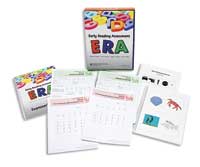
NEW!
Ages: 4-0 to 7-11 years
Testing Time: 5–10 minutes
Administration: Individual
Early Reading Assessment (ERA)
The Early Reading Assessment (ERA) is an easily administered norm-referenced screening test designed to identify those young children who have reading problems. It has high reliability, is empirically validated, and was normed on a representative sample of 1,001 children from 8 states.
Classroom teachers, special educators, speech pathologists, and school psychologists can easily administer and score the ERA subtests. Three of these are core subtests, the results of which are combined to create the Early Reading Index (ERI); the other 2 are supplemental subtests.
Core Subtests and Composite Index
The three core subtests measure print competence pertaining to the alphabet, word identification, and word comprehension using both silent and oral formats. The content of these subtests measure both early manifestations of real reading and requisite skills that lead directly to real reading.
- Written Word Vocabulary (WWV)—measures print knowledge. In this subtest, the child is shown a picture or letter that is accompanied by an array of five choices (words, letters, numerals, or symbols). The child is asked to point to the choice that goes with the stimulus. This subtest is not timed. Of all the subtests, this one is the most like “silent word reading comprehension.”
- Rapid Orthographic Naming (RON)—measures letter-word identification and comprehension knowledge. In this subtest, the child is shown a stimulus card containing pictures, letters, numerals, and words. The child is given 60 seconds to name as many as he or she can. Of all the subtests, RON is most like “oral word reading fluency.”
- Silent Orthographic Efficiency (SOE)—measures the speed with which children can match letters and words. In this subtest, the child is shown a stimulus box that contains a letter or word and is instructed to mark one of five choices that contain the same text that appears in the stimulus box. The child is given 60 seconds to respond to as many items as he or she can. This subtest is most like “silent word reading fluency.”
- Early Reading Index (ERI)—The normative score that is formed by combining the results of the core subtests is called the Early Reading Index (ERI) and is a type of standard score. The Index is the most clinically useful score on the ERA because it is the most reliable score on the test; worth noting is that the ERI has neither floor nor ceiling effects at any age level.
Supplemental Subtests
The supplemental oral language subtests measure important non-print correlates of reading.
- Phonological Awareness (PA)—measures ability to discriminate among and manipulate phonemes. The child deletes phonemes, affixes, or words from words spoken by the examiner.
- Receptive Vocabulary (RV)—measures understanding of common vocabulary. The child points to the picture of a word spoken by the examinee. This is a common format used to measure a language ability variously called “receptive oral vocabulary,” “listening vocabulary,” or “picture vocabulary.”
Scores Available
The ERA yields age equivalents, percentile ranks, scaled scores, and a composite, the Early Reading Index. Subtest standard scores have a mean of 10 and a standard deviation of 3. The Index has a mean of 100 and a standard deviation of 15.
Statistical Characteristics
The ERA scores satisfy the most demanding standards of reliability. The reliability coefficients for all the subtests exceed .80. The reliability for the index is .94, indicating near perfect reliability. ERA scores are equally reliable for all major demographic subgroups investigated. The scores for the ERA core subtests (i.e., WWV, RON, and SOE) demonstrated large to very large correlations to 5 criterion reading scores (TOPEL, TERA-3, WJ III, TOSWRF, and TOSREC). Evidence is presented to show that the ERA Early Reading Index score can be used effectively to screen for poor readers. The results from a binary classification analysis showed a sensitivity index of .81 and a specificity index of .83; only 5 false positives were identified. The value of .92 reported for the ROC curve is considered excellent.
Complete ERA Kit (Order #1026) Includes: Examiner’s Manual, Picture Book, 25 Examiner/Record Forms, the RON Stimulus Card, and 25 SOE Student Record Forms all in a sturdy storage box. (©2012)| 1026 | ERA Complete Kit | $303.00 |
| 1026a | ERA Examiner’s Manual | $101.00 |
| 1026b | ERA Picture Book | $105.00 |
| 1026c | ERA Examiner/Record Forms (25) | $63.00 |
| 1026d | ERA RON Stimulus Card | $32.00 |
| 1026e | ERA SOE Student Record Forms (25) | $35.00 |
| 1026ae | ERA Virtual Examiner’s Manual | $101.00 |
| 1026be | ERA Virtual Picture Book | $105.00 |
| 1026de | ERA Virtual RON Stimulus Card | $32.00 |
Order #1026